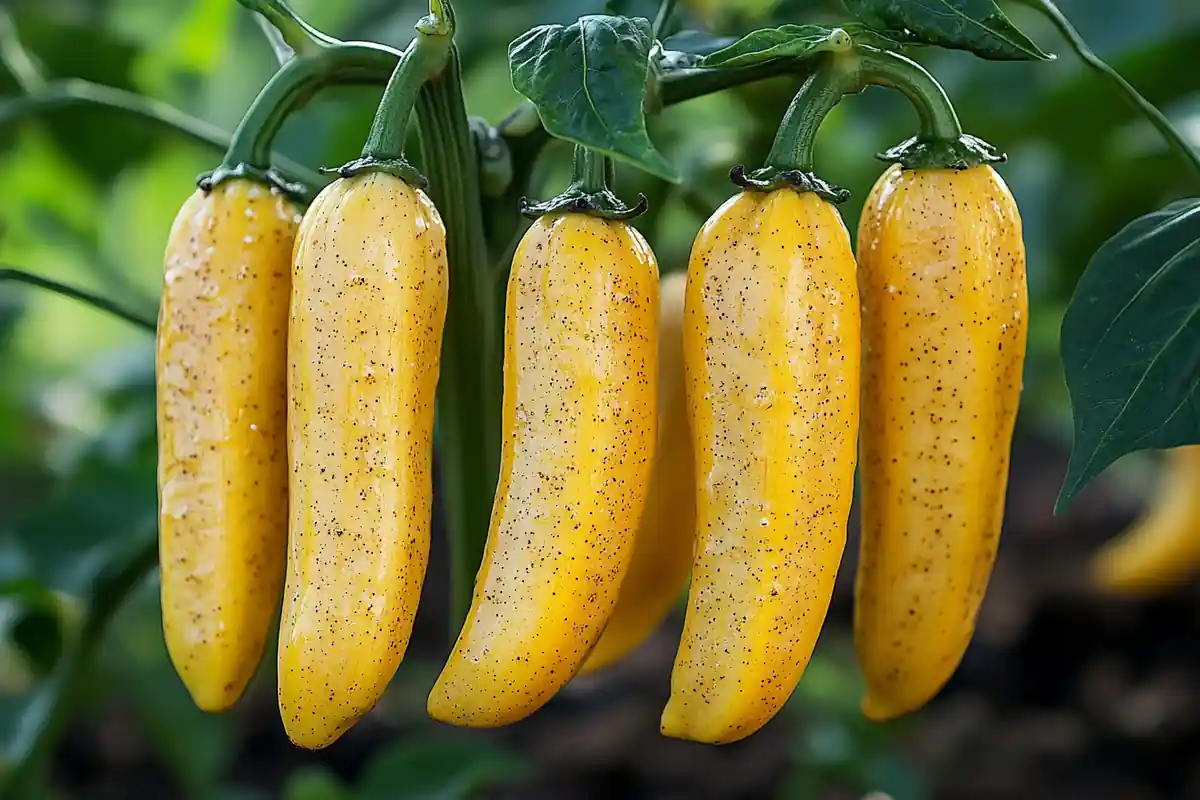This comprehensive guide explores the banana pepper, its characteristics, and how to use it. Discover everything about this versatile pepper.
What is a Banana Pepper?
The banana pepper, also known as the yellow wax pepper, is a medium-sized chili with a mild taste. It’s named for its banana-like shape and vibrant yellow color. These peppers are popular for their gentle flavor and various uses in cooking. Banana peppers are not very spicy, making them enjoyable for most people.
The Origins of Banana Peppers
Banana peppers come from Central America. They now grow in many different places worldwide. They belong to the Capsicum annuum family, similar to bell peppers and jalapenos. Banana peppers are valued for their mild taste and are easy to grow, making them common in home gardens.
The Banana Pepper Flavor Profile
Banana peppers have a slightly sweet and tangy flavor. Their mildness makes them different from hotter peppers. The zestiness of banana peppers makes them great for many dishes. They provide a nice kick without being overpowering. Their distinct taste compliments various cuisines.
How Banana Peppers Compare to Other Peppers
Compared to jalapenos, banana peppers have much less heat. They are milder than pepperoncinis and offer a sweeter taste. Unlike bell peppers, they still have a bit of zing. Their characteristic flavor makes them unique. This makes them great for people who like mild heat.
Banana Pepper Nutritional Benefits
Banana peppers are low in calories. They contain some essential nutrients. They are a good source of vitamins like C and A. Banana peppers also provide trace amounts of other vitamins. These nutrients make them good for eating well. Although they aren’t packed with nutrients, they contribute to a balanced intake.
Health Perks of Banana Peppers
Banana peppers are a good source of antioxidants. These help protect cells from damage. Vitamin C in banana peppers can also boost your body’s defenses. Even small amounts of fiber contribute to digestion. Therefore, adding them to meals is good.
Banana Peppers in Cooking: Versatile Uses
Banana peppers are very versatile in the kitchen. They can be pickled, eaten fresh, or cooked. Their mild flavor allows them to be used in various recipes. Adding them to sandwiches, salads, and pizzas is very common. You can even use them as a tasty filling.
Pickling Banana Peppers
Pickling is a common way to use banana peppers. This method helps to preserve them and improve their flavor. Pickled banana peppers are perfect on sandwiches and relish trays. Pickling also makes the pepper softer. The process brings out their great tangy flavor.
Popular Banana Pepper Recipes
Many recipes use banana peppers. They are a good addition to:
- Sandwiches and wraps for a zesty touch.
- Pizzas, adding a subtle flavor.
- Salads for a tangy crunch.
- Nachos, offering a mild bite.
- Tacos for an extra layer of flavor.
- Pickled mixes, enhancing the flavor.
- Stuffed pepper recipes, adding a unique taste.
Stuffed Banana Pepper Recipe
Stuffed banana peppers are a delicious option. Here’s a simple way to make them:
- Cut banana peppers lengthwise and remove the seeds.
- Mix together your choice of stuffing, such as breadcrumbs, cheese, and herbs.
- Fill each pepper with the mixture.
- Bake or grill until the peppers are soft.
Preparation Tips for Banana Peppers
- Wear gloves when handling to prevent skin irritation.
- Always wash them before cutting or cooking.
- Remove the seeds to lessen the heat if desired.
- Cut them as needed for your recipe.
How to Store Banana Peppers
Proper storage helps maintain the freshness of banana peppers. Fresh peppers should be kept in the refrigerator. Pickled banana peppers should be stored in a sealed container in the fridge. It’s important to always check the labels for specific storage advice.
Storing Fresh Banana Peppers
Keep fresh banana peppers in a plastic bag. Put them in the crisper drawer of your fridge. For the best results, use them within one week. Check for any signs of softening to make sure they are fresh.
Storing Pickled Banana Peppers
Pickled banana peppers should always stay in the refrigerator after opening. Keep them in the pickling liquid to keep them moist and flavorful. Close the lid tightly to preserve the freshness and taste.
Growing Banana Peppers at Home
Growing your own banana peppers is easy and rewarding. They are a great option for home gardens. Good soil and consistent watering are key for best results.
When to Plant Banana Peppers
Plant banana pepper seedlings once the frost has passed. They need warm weather to grow. Start them indoors a few weeks early for a head start. Always check local guides for planting times.
Tips for Growing Healthy Banana Peppers
- Water them regularly.
- Ensure they get a lot of sunlight.
- Plant them in well-draining soil.
- Use seasoning as needed.
- Support them as they grow to keep the plant upright.
Banana Peppers on the Scoville Scale
The Scoville scale measures the spiciness of peppers. Banana peppers are typically at the bottom, ranking from 0 to 500 SHU (Scoville Heat Units). This makes them extremely mild. Some may have more heat due to different growing conditions. The low SHU means they are great for people who don’t like spicy food.
Understanding Scoville Heat Units
- 0 SHU: Bell peppers (no heat)
- 0-500 SHU: Banana peppers (very mild)
- 2,500-8,000 SHU: Jalapenos (mild to moderate heat)
- 100,000-350,000 SHU: Habaneros (very hot)
Factors Influencing Banana Pepper Heat
Although usually mild, banana peppers can sometimes be a little hotter. The growing environment greatly affects their heat levels. Try a small piece first if you’re worried about the spiciness. Remove the seeds to lessen the heat.
Flavor Pairings with Banana Peppers
Banana peppers blend well with a variety of flavors. They pair nicely with cheeses, herbs, and meats. Their tangy taste can also compliment richer foods. This makes them quite flexible in the culinary world. They enhance both simple and complex dishes.
Banana Peppers and Cheese Combinations
Banana peppers and cheese create a winning taste combination. They go well with feta, mozzarella, cheddar. and They are an ideal choice for a cheese board or a cheesy sandwich.
Using Banana Peppers with Meats
Banana peppers also work great with meat dishes. They are a fantastic addition to sausages and burgers. Pickled banana peppers are a popular topping for pulled pork sandwiches. They create a unique flavor in various meat recipes.
Banana Pepper Recipes: Further Exploring
Let’s explore more unique recipes using banana peppers. These recipes showcase their versatility. They add a good tang and flavor. Try these ideas to add something extra to your meals.
Banana Peppers in Egg Dishes
Banana peppers can brighten up scrambled eggs. They also taste great in omelets. Try dicing them and adding them into your eggs for extra flavor. Their taste is a great match for classic breakfast meals.
Recipe for Banana Pepper Scramble
- Whisk eggs and a bit of milk together.
- Sauté diced banana peppers in a pan.
- Add the egg mixture to the pan.
- Cook until the eggs are set and done.
Banana Peppers in Salads: A Tangy Addition
Banana peppers add a great flavor to salads. They taste great with lettuce, cucumber, and tomatoes. They liven up simple salads, adding a tasty touch. Both fresh and pickled banana peppers can be used.
A Simple Banana Pepper Salad Recipe
- Combine mixed greens, cucumber, and tomatoes in a bowl.
- Add sliced banana peppers.
- Drizzling with a vinaigrette dressing.
- Toss gently to combine all the items.
Sauces and Relishes with Banana Peppers
Banana peppers add a nice depth to sauces and relishes. Their tangy taste compliments many vegetables. Use them either fresh or pickled in your favorite sauces.
Quick Banana Pepper Relish Recipe
- Chop banana peppers finely.
- Mix with onion, vinegar, and a bit of sugar.
- Simmer until it thickens up.
- Let it cool before you serve.
Alternatives to Banana Pepper
When you can’t find banana peppers, there are other options. Keep in mind that substitutes can change a recipe’s taste. Each alternative offers a different taste. Choose one carefully to get the desired flavor.
The Best Banana Pepper Substitutes
- Pepperoncini: similar in flavor, but usually more tangy.
- Sweet bell peppers: mild and sweet, but no heat.
- Poblano peppers: mild heat with a distinct taste.
- Anaheim peppers: offers a similar level of mild heat.
Choosing a Substitute for Your Needs
For pickling, pepperoncini works as a decent replacement. Sweet bell peppers are good for adding to salads. If you need a bit of heat, try poblano or Anaheim peppers. Each recipe may need its own specific adjustment.
Frequently Asked Questions about Banana Pepper
Here are some common questions about banana peppers. These answers will help clarify more points about this pepper. It should make sure that no questions remain unanswered.
What is the Flavor of a Banana Pepper?
Banana peppers have a tangy, slightly sweet, and very mild flavor. They provide a gentle kick without being too spicy. This characteristic taste makes them good for so many uses.
How Spicy are Banana Peppers?
Banana peppers are very low on the Scoville scale, usually ranging from 0 to 500 SHU. This mildness makes them a favorite for anyone who dislikes a lot of heat. Therefore, you can use them freely in most situations.
are Banana Peppers the same as Pepperoncini?
No, banana peppers and pepperoncini are different. Banana peppers are sweeter and milder, while pepperoncini peppers are more tangy and often have a bit more spice. Varieties of taste make each one unique.
Can Banana Pepper Get Hotter Over Time?
Yes, banana peppers can develop a little more heat if they are left to mature longer on the plant. Growing conditions also contribute to the level of heat. But most remain mild.

